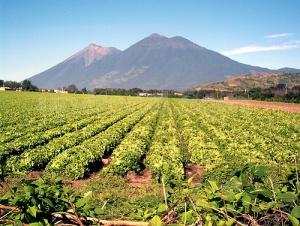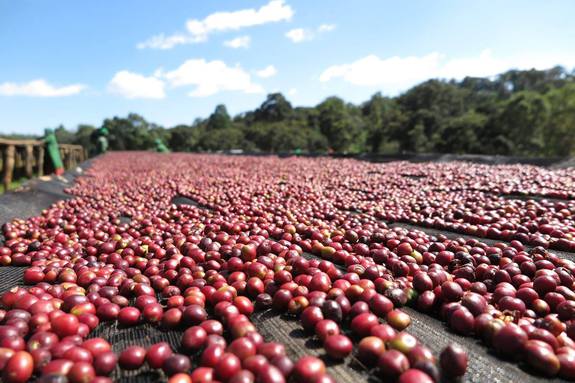The situation of coffee industry in Vietnam and its determination to change
During the period from 2001 to 2005, the world coffee market fluctuated, and the crisis of oversupply had a very negative impact on the income of coffee growers and their related employees. In recent years, the annual supply of medium-grain coffee in Vietnam is 120-14 million bags (60 kg / bag). In this crisis, the Vietnamese coffee industry has encountered many difficulties, but it has also gained experience and defined the development direction of the Vietnamese coffee industry.
(I) the problems highlighted by Vietnam in the world coffee crisis
Vietnam began to produce coffee as early as the 20th century, but it has only developed in the last 25 years, and its area and production capacity have been greatly improved. In the past 25 years, Vietnam's coffee production has increased 100-fold, making it the second largest coffee producer in the world. From 1994 to 1998, due to high market prices and large profits, many growers planted coffee on a large scale, the output of coffee exceeded the scope of government control, and the planting area also exceeded the planned area, resulting in loss of balance with other crops and, more importantly, it also led to the abuse of land and water resources. The planting area of medium-grain coffee has increased many times in a short period of time, with coffee plantations covering 500000 hectares of fertile red basalt soil in the central plateau and the southeast, impacting the development plans of rubber, pepper, cocoa, cashew and other crops. Another consequence of overgrowing coffee is that a large amount of water is needed to irrigate coffee during the dry season, which consumes groundwater in many coffee-growing areas. During the 2004 dry season, some provinces in Vietnam had to give up thousands of hectares of rice to save water and save thousands of hectares of coffee. All these are the shortcomings of Vietnam's coffee industry. In addition, Vietnam's annual supply of 1 million tons of medium-grain raw coffee beans also greatly affects the balance of supply and demand and the price of coffee in the international market. It puts not only nearly 1 million coffee growers in Vietnam in trouble, but also 25 million coffee producers around the world. The low price of coffee has led to a decline in the income of growers, who do not have the funds to meet their living needs and reinvest in plantations. Because coffee has to be sold at low prices, sometimes even below the cost of production, growers have lost interest in growing coffee and neglect to manage coffee trees or switch to other crops. This is a negative phenomenon often encountered by the Vietnamese coffee industry a few years after coffee prices peaked and began to decline, which is why Vietnam began to decline in the years when production reached its peak.
In winter and spring, the severe drought in the central plateau (the main coffee producing area of Vietnam) led to the lowest coffee production. In 2005 and 2006, coffee production is expected to be only 1-10.5 million bags. Vietnamese coffee producers have learned a useful lesson from the crisis that the Vietnamese coffee industry must benefit from it with the world coffee industry. In the face of this dilemma, the Vietnamese coffee industry has reflected on these lessons and determined the correct coffee development strategy according to the changes in the market to put it on the track of reasonable development.

(2) Seven improvement measures
1 to study the reasonable industrial structure of grain and small seed coffee.
First of all, the reasonable proportion of medium-grain coffee and small-grain coffee was discussed. Vietnam began to develop the cultivation of small-grain coffee in 2005, mainly Catimor varieties with few leaves (hybrids of Caturra and Timor). Therefore, it is necessary to seriously explore the proportion of small-grain coffee and medium-grain coffee. The climatic conditions in Vietnam allow medium-and small-grain coffee to be grown in different parts of Vietnam. The land of Viet Nam extends along the meridian above 15 °N, which provides a favorable environment for the cultivation of medium-grain and small-grain coffee, which can be grown in the south with hot and humid climates. small-grain coffee can be grown in the northern mountains with temperate climates or in the south above 800,000m above sea level. In fact, it has been proved over the years that medium-grain coffee can develop steadily in Vietnam. The high temperature and heavy rainfall in the central plateau can make the medium-grain coffee tree grow rapidly, and its high yield can be ensured if irrigation is carried out in the dry season and flowering and fruiting stage. The production potential of medium-grain coffee in fertile red basalt soil has been tapped. Although Viet Nam also has a large labour force and a hot and humid tropical climate to fully develop medium-grain production, it is necessary to consider the relationship between the planting area and irrigation capacity of medium-grain coffee. There are many undeveloped areas in the highlands of Vietnam, especially in the north and northwest of Vietnam, which are very suitable for growing small-grain coffee. After many years of investigation, several small seed cultivation areas with good development prospects have been identified, namely: the north-west region, mainly in the Dien Bien and Son La areas; and the central region, mainly in the Khe Sanh province of Nghe An province and the southern region of A Luoi; in the province of ThuaThien Hue, mainly in the cities of ia Lai,M'Drak,Dak Nong,Lam Dong and DaLat. Bourbon coffee is of good quality and is popular with consumers, and its aroma is comparable to that of light coffee in Central America. It can be seen from this survey that it is necessary to reduce the cultivation of low-benefit medium-grain coffee and expand the planting of small-grain coffee in areas with suitable ecological conditions. The key strategy of Vietnam's coffee industry is to reduce its coffee acreage and output. The Vietnamese coffee industry only needs to provide an appropriate amount of high-quality raw coffee beans to the market every year to meet the needs of consumers, which is the right direction to guide the Vietnamese coffee industry to integrate into the international coffee market.
2 to improve the key technologies
In order to overcome the above-mentioned shortcomings, the Vietnamese coffee industry focuses on environmentally friendly production and biodiversity production. Coffee producers no longer use chemical fertilizers in pursuit of high yield, irrigate large amounts of water and cut down shade trees during the dry season, while taking into account the protection of the environment and the hygiene of processed food. The following measures are taken to improve: (1) planning and design of coffee plantations to avoid soil erosion; (2) taking into account the relationship between coffee shading trees and production diversification; (3) using organic fertilizers instead of chemical fertilizers to link livestock raising with crop growth (suitable conditions for raising cows in coffee plantations and manure for plantations); (4) using scientific methods to prune coffee trees (5) increase the planting of mulch in the dry season to maintain soil and moisture, and adopt moderate and effective irrigation; (6) pick coffee fruits when they reach suitable maturity, do not pick immature, overripe, withered or shedding fruits; (7) minimize the harm of coffee treatment wastewater to the environment; (8) actively publicize and promote advanced cultivation techniques to growers. The coffee industry has put forward "three reductions, three increases and one ban", three reductions refer to: reducing costs, reducing the use of pesticides, and reducing the amount of coffee irrigation; three increases refer to increasing shade trees, increasing organic fertilizers, and increasing pruning; one prohibition refers to the prohibition of picking or picking immature, overripe or withered fruits. In addition, licenses and certificates issued by UtzKapeh certification bodies (Rainforest Alliance, which certifies organic coffee) required by registered consumers are required to participate in fair trade in coffee.
(3) improve the quality of coffee and produce products with high added value
This is a weakness that the Vietnamese coffee industry needs to be improved as pointed out by World Bank experts in the Vietnamese coffee industry report. There is a need to strengthen the production and investment of high value-added coffee products. The World Bank also believes that Vietnam should produce mixed coffee products. Therefore, the production cost of coffee can be reduced and can meet the needs of consumers. If only raw coffee beans and low value-added coffee products are supplied to the market, Vietnamese coffee will lose its competitiveness in the market.
(4) the production of high-quality coffee is the inevitable choice of Vietnam coffee industry.
As the main coffee product is medium seed coffee, Vietnam will imitate the development plans of C ô te d'Ivoire, Ghana and other African countries to focus on the production of high quality medium seed coffee, and the most important thing is to improve the processing technology of coffee and improve and stabilize the quality of coffee to attract consumers.
5 to promote domestic coffee consumption
We should promote and pay attention to the domestic consumption of coffee in Vietnam. From the experience of Brazil, Colombia, Indonesia and India, it is necessary to develop plans to promote the consumption of coffee in Viet Nam, mainly to encourage and promote domestic consumer consumption, so that the annual domestic consumption of coffee exceeds 1 million bags. The relationship between coffee and health should be introduced by organizing conferences, exhibitions, publishing books, papers and newspapers, and domestic people should be encouraged to drink more coffee.
6 pay attention to the society and promote the development of coffee production
According to data from the General Administration of Statistics of Viet Nam in 2003, there are 561000 coffee growers in Viet Nam, of which 46 per cent are poor and 30 per cent are ethnic minorities (75 per cent of whom are poor). In the past few years, the coffee industry has brought comfort to many families, but now the crisis has put their lives in a difficult position. As a result, ethnic minorities in some areas began to plant upland rice, corn, beans and other crops to increase their income. Coffee is no longer seen as a tree that can change poverty, nor can it be planted by the poor, and now only well-off farmers can invest in large-scale coffee cultivation. At present, the issue that coffee industry policy makers need to consider is how to create jobs and increase the profitability of poor farmers on coffee, which also helps to eradicate hunger and reduce poverty.
The government should invest in the construction of warehouses for growers to store coffee; at the beginning of planting, the government should provide advance payments to growers at a reasonable price and buy them at a high price. When the price of coffee is low, coffee growers will not sell all the coffee, so it is necessary to provide an information market system for coffee trading in the main coffee producing areas.
7 establish a cooperative organization
Now is the right time to establish coffee professional cooperation organizations, which can be used to help growers import and export their products, jointly develop coffee processing products, and cooperate to develop coffee production. Profits can not be made from these cooperative organizations, but from collaborative cooperation. Cooperation among professional organizations also contributes to the establishment of non-governmental networks for agricultural development and provides favorable conditions for the dissemination of advanced production technologies. This is a new type of cooperative organization that helps growers understand the market, integrate into the market and get in touch with relevant experts.
To establish such a cooperative organization, the government must sponsor funds and projects and combine professional cooperation with the application of new technologies. Therefore, in order to overcome the disadvantages of individual growers, the coffee industry must connect the participants with the market and improve the competitiveness of Vietnamese coffee.

(3) Sustainable development of coffee industry in Vietnam
Compared with other coffee-producing countries, Vietnam's coffee industry started late and suffered a severe blow in this crisis. Therefore, Viet Nam tries to revive the Vietnamese coffee industry by participating in a number of activities organized by the following international coffee organizations: (1) propose national coffee standards as the basis for market transactions. So far, Vietnam has issued nearly 30 national standards for coffee. From 1986 to 2005, the production technical specification TCVN4193 in Vietnam has been inspected, revised and added 3 times. Vietnam Coffee-Cocoa Association actively participated in the activities of ICO's Coffee quality Committee (CQC) and jointly participated in the formulation of Article 407 of ICO. (2) with the help of FAO, a programme on "improving the quality of coffee to prevent the formation of soot disease and ochratoxin A contaminated coffee" has been implemented, and subjects such as TOT (training of trainers) and TOF (training of growers) have been organized, technical backbones have been sent to various places for training and learning, and laboratory equipment has been updated and upgraded. The activities mentioned above are aimed at protecting the environment and ensuring food hygiene; (3) with the help of E.D.E and foreign organizations such as Germany, the Netherlands and Switzerland, the PPP plan (state-owned, private and joint venture schemes) which contributes to the sustainable development of the coffee industry has been implemented. These three models of coffee production have been promoted in QuangTri, Son La and Daklak; (4) targeted research on the registration licenses and certificates approved by Utz Kapeh. Vietnam also specially cooperates with international consumer organizations to study the above contents in order to contribute to the sustainable development of the coffee industry. In addition, the coffee industry in Viet Nam also participates in the United Nations Environment Programme (UNEP) and 4C (aimed at promoting the sustainable development of the coffee industry and raising the income of growers). These activities show that although there are many problems in the Vietnamese coffee industry, we still want to try our best to integrate into the world coffee family, hoping to get help from the international coffee organization and the world coffee family to promote the sustainable development of the Vietnamese coffee industry.
Source: Institute of Science and Technology Information, Chinese Academy of Tropical Agricultural Sciences
Important Notice :
前街咖啡 FrontStreet Coffee has moved to new addredd:
FrontStreet Coffee Address: 315,Donghua East Road,GuangZhou
Tel:020 38364473
- Prev

Nescafe has collected 10,000 heart-warming stories, and a cup of coffee is a copy.
Professional barista communication Please pay attention to coffee workshop (Weixin Official Accounts cafe_style) Thank you for appearing, enough for me to like for many years; I would like to break into your world and break your single cycle; a child in the sun, an adult in the wind and rain. These heartfelt messages are written in the recently launched H5 "Meet Ten Thousand Surprises Here" of Nescafe Silky Latte. Nespresso coffee in this gradual
- Next

Caffitaly Cafe Red Italian Fine Aesthetics Cafe China
Recently, Caffitaly, a capsule coffee machine brand from Italy, joined forces with fashion blogger Rebecca to launch the Caffitaly Coffee Red House project to transform the way coffee corners in the home are active and attract attention in the circle. Rebecca cooperated with Caffitaly this time and moved China's first Caffitaly coffee house into her home. What charm does this Caffitaly coffee house have?
Related
- Why are the coffee in some coffee shops not enough after being frozen? What should I make up for my American latte cappuccino coffee after being frozen?
- How much water does it take to steam coffee by hand? Why is the coffee brewing and steaming time 30 seconds? What is the purpose of steaming coffee?
- The suspected drink contains too much caffeine! Overlord Tea Lady responds urgently!
- Starbucks rejects antique paper coupons?! Netizen: Missed marketing opportunities!
- What ratio of water temperature and ground does the smart cup method use to press coffee? The difference between brewed coffee and filtered coffee?
- What is the standard process for the purpose of coffee cup testing? What is the difference between hand-brewed coffee and cup testing?
- How to use hand-brewed coffee paragon small golden balls? How does cold coffee lock in the aroma of coffee?
- Is American coffee black? What is the difference between American coffee and drip coffee?
- Unexpected! Well-known tea beverage brand Lele Tea will withdraw from the Zhengzhou market!
- Starbucks enters the fashion and beauty industry?! Netizen: Give me an ice American eye cream

